INTRODUCTION

With the recent release of the GeForce series 7 graphics cards NVIDIA has once again taken the crown for the single most powerful graphics processing unit and although many of us hope that AMD can bring something to match them soon for the sake of competition (and in turn lower prices) things are not that easy. Regardless however although all three cards announced in the series 7 are quite remarkable not everyone has the ability to get one and so with series 6 prices naturally taking a significant hit this just might be the best time for people to invest on one of the previous generation models. Today on our test bench we have the last addition in the GeForce series 6 line by Gainward the 650 Ti BOOST 2GB Golden Sample.
Gainward Co. Ltd was founded in Taipei back in 1984 with a single goal, to produce a variety of innovative PC video enhancement products. In 1989 Gainward starts production of new VGA technology and becomes a major developer for Tseng Labs ASIC in Taiwan. Their USA presence was officialized in 1991 and by 1992 Gainward was ranked Top 1000 Industrial companies in Taiwan. TNC Industrial Co. Ltd. merged with Gainward in 1997 and with that move they became one of the largest graphics cards suppliers, shipping more than 2 million boards during the year. In 2000 Gainward establishes their presence in Europe with a new branch in Germany while in 2001 they become an NVIDIA Certified Selection Solution Provider and NVIDIA Launch Partner. Gainward and Palit Microsystem Inc. merge together in 2005 to ensure a higher level of accessibility and the highest possible product quality. In 2006 they introduce a new company logo which they change again in 2008 when they become an AMD authorized partner.
Under the hood of the 650 Ti BOOST we find the GK106 graphics processor featuring 768 Shader units, 24 ROPs (Raster Operators), 64 TMUs (texture memory units) and 2540 million transistors along with 2GB (2048) GDDR5 RAM. Much like every Golden Sample graphics card by Gainward the 650 Ti BOOST 2GB GS comes overclocked from the factory and thus features a core clock speed of 1006MHz (boost up to 1072 MHz) and a memory clock set at 3054MHz (6108MHz effective) which in turn translates to a total of 146.6GB/s memory bandwidth. Worth mentioning is that the overclock given by Gainward is one of the highest factory overclocks currently available for the GeForce GTX 650 Ti BOOST 2GB so that alone should go a long way especially for people who will don't intent on spending time on overclocking. Now since we haven't been focusing on graphics card reviews lately we can only place it up against a handful of cards but that should be more than just sufficient to see just how good this solution by Gainward really is.
SPECIFICATIONS AND FEATURES

PACKAGING AND CONTENTS
Gainward once again ships their card inside a tall box with their logo at the front along with the Golden Sample logo and a list of the main product features.
The benefits of having an NVIDIA graphics card along with the system requirements are placed at the rear.
As you can see the card is placed between several pieces of cardboard and inside a anti-static bubble bag.
The package contains the GeForce GTX 650 Ti BOOST 2GB GS graphics card, twin Molex to 6pin power adapter, DVI-D adapter, software CD, quick install guide and a coupon giving you a 20% discount on several software suites.
THE GEFORCE GTX 650 TI BOOST 2GB GS
The Gainward GeForce GTX 650 Ti BOOST 2GB GS is a two slot solution and measures 190mm in length and 112mm in height.
Much like most Golden Sample graphics cards by Gainward the GeForce GTX 650 Ti BOOST 2GB GS features two 92mm fans.
A single 6pin power connector is required for the card to work.
 Aside the two 92mm fans the cooling system is based on two 8mm heatpipes passing through a large heatsink made out of 35 aluminum fins.
Aside the two 92mm fans the cooling system is based on two 8mm heatpipes passing through a large heatsink made out of 35 aluminum fins.
Gainward has used a black PCB that looks quite nice.
You can connect up to 4 displays simultaneously on the card via the available HDMI, DisplayPort, DVI-D and DVI-I ports.
TEST BED


TESTING METHODOLOGY

As always we do our best to perform all tests with the latest possible drivers (even beta ones), however due to time issues and also because some older models are no longer in our hands sometimes this will simply not be possible. This time over we did sit down to rebench every single card from the ones we've tested so far using the latest possible drivers however this will probably be a one-time thing (we will be doing this however each time we change our game selection). The drivers used to benchmark each of the cards are noted in the list beneath. Also take into account that all tests are performed with the default driver settings in both the Catalyst Control Panel and the NVIDIA Control Panel (power management modes are set to maximum performance) to keep things even for both camps.
Gainward GeForce GTX 650 Ti BOOST 2GB GS - GeForce 320.49 Beta
HIS Radeon HD 7750 iCooler 1GB - Catalyst 13.6 Beta
Gainward GeForce GTX 670 Phantom 2GB - GeForce 320.49 Beta
HIS Radeon HD 7850 iCooler 2GB - Catalyst 13.6 Beta
HIS Radeon HD 7770 iCooler 1GB - Catalyst 13.6 Beta
Gainward GeForce GTX 590 3GB GS - GeForce 320.49 Beta
Once again the screen used for all the benchmarks is our primary NEC 30" 3090WQXi LCD with a maximum resolution of 2560x1600. Unlike in the past and since quite a few of you asked instead of having multiple different settings and just 2 resolutions we decided to have a total of 3 resolutions (2560X1600, 1920X1200, 1680X105) to cover most readers with a single quality setting (4xAnti Aliasing / When possible through in-game settings) to make it easier to pinpoint the differences between cards (more FPS, easier to see). Once again we have changed our game lineup and so until something more demanding comes along we will be using Crysis 3, Battlefield 3, The Elder Scrolls V Skyrim, Bioshock Infinite and Metro Last Light. For these benchmarks we maxed out the graphics settings of each game and also updated them to their latest versions. All tests were repeated 3 times and in a fresh Windows 7 Ultimate Service Pack 1 64Bit installation on an OCZ RevoDrive 3 240GB SSD. As usual all tests took place in a room with a controlled ambient temperature of 23 degrees Celsius, the temperatures of the cards were recorded using AIDA64 (former Everest Ultimate by Lavalys) and GPU-Z while the noise levels were recorded using our ExTech HD600 dBA meter from a distance of no more than 5-10cm away.
TEST RESULTS - BATTLEFIELD 3



TEST RESULTS - CRYSIS 3
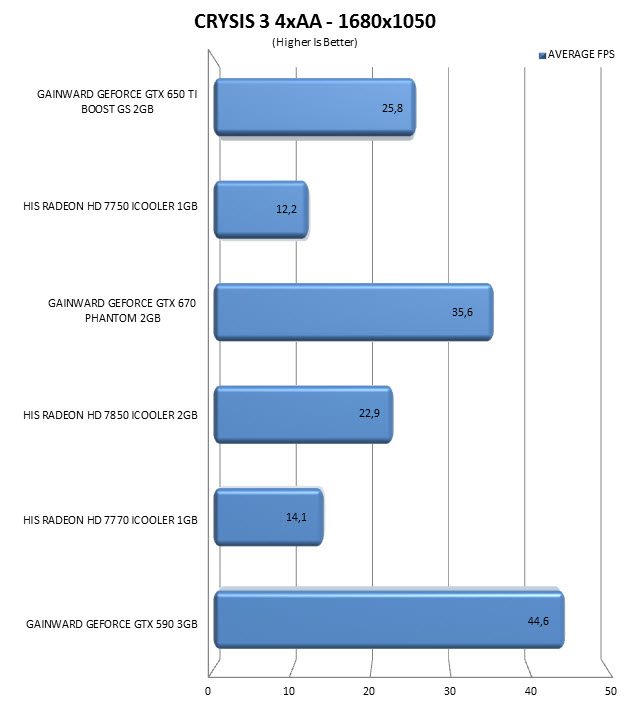

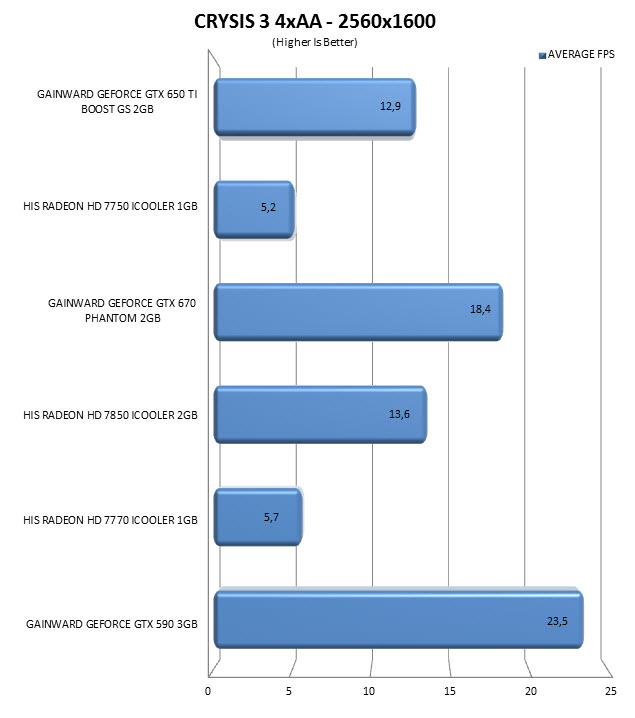
TEST RESULTS - THE ELDER SCROLLS V SKYRIM



TEST RESULTS - BIOSHOCK INFINITE
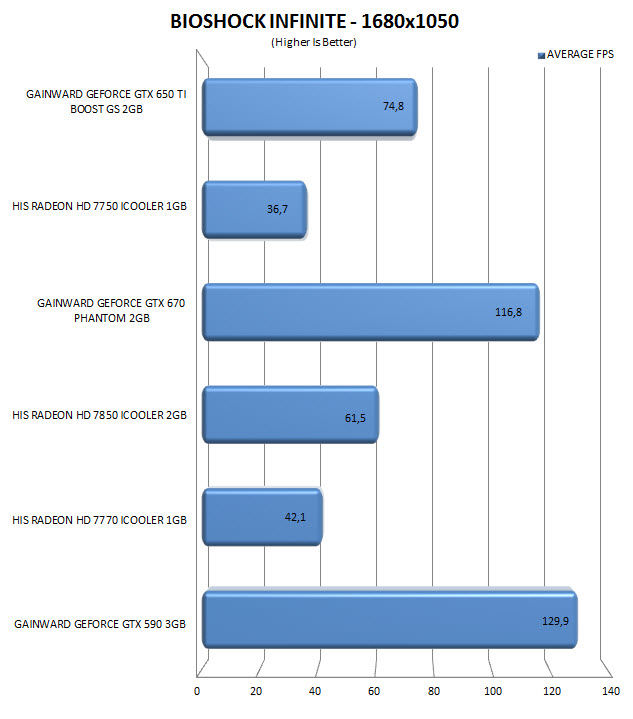


TEST RESULTS - METRO LAST LIGHT



TEST RESULTS - TEMPERATURES / NOISE LEVELS / POWER CONSUMPTION



TEST RESULTS - OVERCLOCKING

The default core clock is set at 1006MHz and after a bit of tweaking and messing around with the Gainward EXPERTool we managed to hit 1096MHz (+8.3%). Things were even better on the memory speed area and so from the stock 3054MHz we managed to squeeze another 400MHz adding up to a total of 3454MHz (+11.5%).

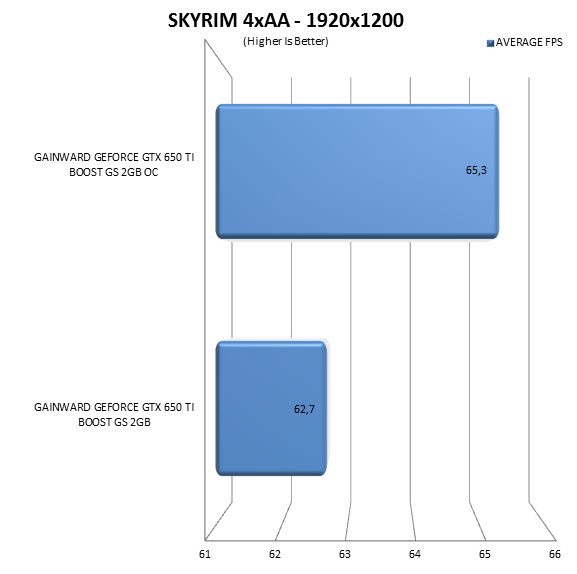

This mild overclock gave a boost in performance of slightly over 7% in Metro Last Light and 4% at The Elder Scrolls V Skyrim at the cost of two degrees Celsius.
CONCLUSION

With the GeForce GTX 650 Ti BOOST 2GB Golden Sample Gainward has successfully introduced a graphics card that can easily fill the gap between the normal GTX 650 and the GTX 670 largely thanks to the very good factory overclock. Granted as many of you are well aware the GeForce GTX 660 Ti model is also present in the market and is placed right beneath the GeForce GTX 670 which in turn means that it's also faster (compared to the GTX 650 Ti BOOST) but not in such a degree to justify the extra price. Personally after the recent introduction of the GeForce 7 series if i had to go over the Gainward GeForce GTX 650 Ti BOOST 2GB GS I’d probably opt for the GeForce GTX 760 which is a newer model (and thus there's plenty of room for driver improvements), it's slightly faster (even now) and in the long run not really that much further in price compared to the GeForce GTX 660 Ti. Going back to the GeForce GTX 650 Ti BOOST 2GB GS by Gainward there's really nothing wrong with it, performance is very good, noise levels are quite low (a lot lower compared to the Phantom GeForce GTX 670), temperatures are also very low and on top of that the card is quite small allowing it to fit even in m-ATX cases with ease.
One of the things i like about fair competition is that when pretty much every single graphics card manufacturer out there releases their own factory overclocked model (or models) the result is that they don't overprice them and in some cases they even offer them at lower costs compared to the default/stock versions. Of course the more heavily overclocked versions like the Gainward GeForce GTX 650 Ti BOOST 2GB GS cost slightly more and so currently this particular model retails for around USD190 inside the USA and for 165Euros inside the EU (Overclockers.co.uk). With so many GeForce models currently available in the market it all comes down to what kind of games you play (if at all) and at what resolutions so if you play with a maximum resolution of 1920x1200 and you don't want to pass the USD200 price mark then the Gainward GeForce GTX 650 Ti BOOST 2GB GS is probably amongst the best choices currently (especially if you want to have a PhysX hardware compatible system) and that's why we are giving it our Golden Award.
 PROS
PROS
- Build Quality
- Dual Fan Solution
- Good Performance
- Factory OC
- Almost Inaudible
- Low Power Consumption & Temperatures
- 4 Video Outputs (HDMI/DP/DVI-I/DVI-D)
- PCIex 3.0 & DX 11.1 Compatible
- Available OC Headroom
- Price/Performance Ratio
- 2 Slot Solution/Size
CONS
- None

 O-Sense
O-Sense












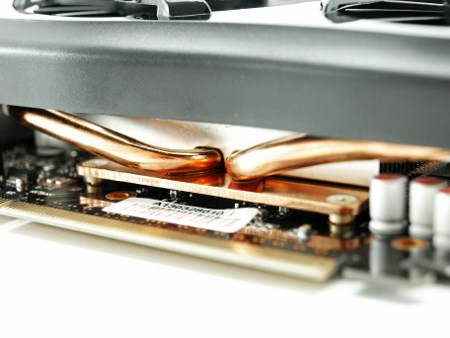




.png)

